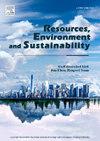Food trade of China saved global land but increased water appropriation and carbon emissions from 2010 to 2020
IF 12.4
Q1 ENVIRONMENTAL SCIENCES
引用次数: 0
Abstract
Global food trade has been growing and diverse with environmental burden shifting across the trade bilateral partners. However, the temporal evolution of the environmental impacts and resources degradations embedded in food trade remains unclear for the recent decades. This study analyzes China’s food supply and trade relationships of 71 food items with 174 countries and territories from 2010 to 2020, examining the associated water, land, carbon footprint (WF, LF and CF) based on the bottom-up method, as well as the corresponding virtual water, land, carbon flows and resources saving. Results show that WF and LF of Chinese food consumption increased while CF decreased over the period. National net virtual water, land and carbon imports more than doubled, mainly due to the import of legumes and nuts from Latin America. Trade conserved 56.6 Mha/yr of land but consumed 30 Gm3/yr of water and raised net carbon emissions by 56 Mt/yr in 2020. This analysis shows a crucial view on the non-negligible role of a certain country’s food trade network changes on global environmental degradations though worldwide food productivity improvements.

2010 - 2020年,中国粮食贸易在节约全球土地的同时,增加了水资源占用和碳排放
随着环境负担在贸易双边伙伴之间的转移,全球食品贸易一直在增长和多样化。然而,近几十年来,食品贸易中环境影响和资源退化的时间演变仍不清楚。本研究分析了2010 - 2020年中国与174个国家和地区的71种食品供应和贸易关系,基于自下而上的方法考察了相关的水、土地、碳足迹(WF、LF和CF),以及相应的虚拟水、土地、碳流和资源节约。结果表明,中国食品消费的WF和LF呈上升趋势,CF呈下降趋势。国家净虚拟水、土地和碳进口量增加了一倍以上,主要是由于从拉丁美洲进口豆类和坚果。贸易节约了56.6万公顷/年的土地,但消耗了30亿立方米/年的水,并在2020年将净碳排放量提高了5600万吨/年。这一分析显示了一个至关重要的观点,即一个国家的粮食贸易网络的变化对全球环境退化的不可忽视的作用,尽管世界范围内的粮食生产力的提高。
本文章由计算机程序翻译,如有差异,请以英文原文为准。
求助全文
约1分钟内获得全文
求助全文
来源期刊

Resources Environment and Sustainability
Environmental Science-Environmental Science (miscellaneous)
CiteScore
15.10
自引率
0.00%
发文量
41
审稿时长
33 days
 求助内容:
求助内容: 应助结果提醒方式:
应助结果提醒方式:


